A lot of drones require you to have a drone pilot licence depending on their weight and the part of the world you live in. If you are someone who has looked into getting your own drone pilot license or remote pilot certificate, you would have come across the Peltier drone course at some point. In this post, we will have a quick run through of what one can expect from the Peltier drone course and if it is a good fit for your needs.
Drones are fun, creative and potentially profitable tools for photographers. They can also be dangerous when flown by unskilled or unqualified pilots. In the early days of drone photography, only a few short years ago, flying was pretty much unregulated. That led, inevitably, to horror stories in the media and general distrust of drones by the general public.
Peltier Drone Course Discount!
If you are serious about taking the Peltier Drone Course, then make sure you secure your discount by using the code “LIGHT15” when making your order.
Something needed to be done. There were videos of drones crashing into tall buildings, drones flying close to aircraft on final approach, and even drones hassling wildlife. In recent years aviation authorities around the world have introduced increasingly stringent regulations. These regulations define not only where and how you fly a drone but also which drones you can fly.
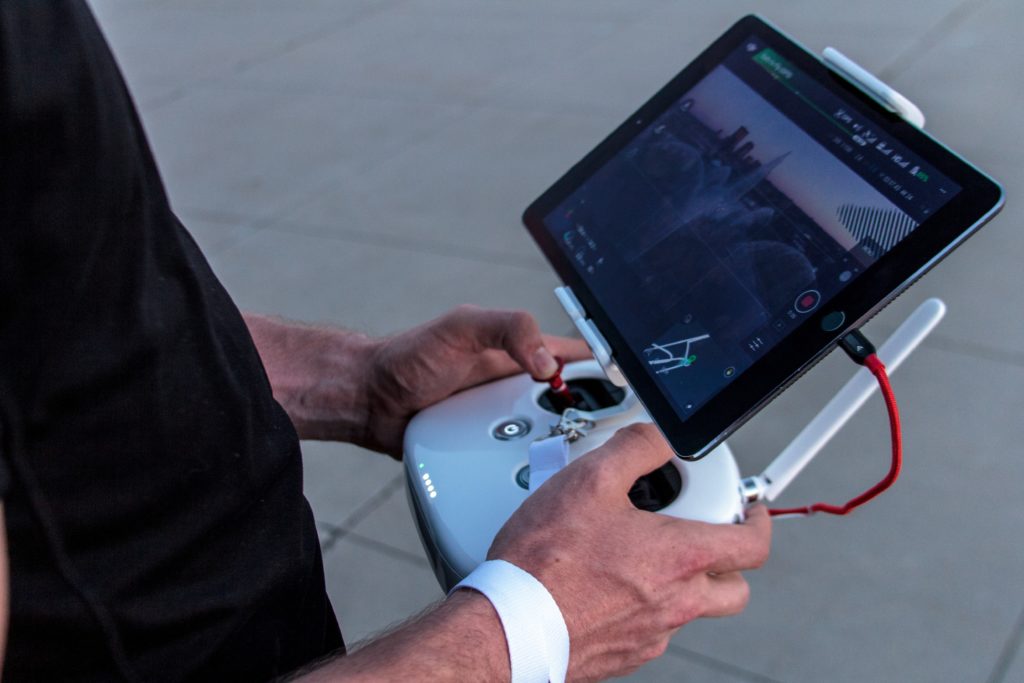
My Experience As A Drone Pilot
If you have been around the hallowed halls of Light Stalking for a while, you will know that I am a keen drone photographer and videographer. In 2018 I passed the CAA PFCO, or Permission For Commercial Operation drone course. The CAA is the UK aviation authority that governs drone flight.
Regulations are changing frequently. New drones are appearing with many more safety features but also people are still finding ways to circumvent current regulations. For the foreseeable future drone regulations will be a moving target.
As an example of this, my PFCO is largely redundant now, replaced with other regulations. Recently I took the CAA A2 CofC exams which allow me to fly drones commercially again in the UK. This is however likely to be superseded in 2023 when further drone regulations come into place.
Regulations Are Good
As a conscientious drone flyer, I welcome responsible regulation and enjoy learning what’s new within the industry. Anything that improves both the safety and outside perspective of drone flying can only be a good thing.
In the United States, the main commercial drone regulation is the FAA Part 107. The be able to qualify for the Part 107, an applicant must be over 16 years of age, demonstrate proficiency in the English language, have the physical and mental capacity to operate a UAS safely, pass a written exam of aeronautical knowledge, and complete a TSA background screening test.
It is a comprehensive test of a person's ability not only to fly a drone but to understand the basics of meteorology, aviation airspace and drone flight dynamics. It requires spending a significant time studying in order to get through the final exam. Like in the UK, the FAA Part 107 coursework can be studied online. Indeed the final exam can now also be taken online rather than having to book an appointment at a local test centre.
You could of course just book an exam and take it, but without significant prior study, you are unlikely to pass. For that reason, there are a multitude of online drone courses that will take you through all the aspects that you need to study. But which course should you choose? Obviously, you would want to be tutored by someone who has a proven track record in the industry and to do a course that is constantly updated as regulations change. That brings us neatly to the Peltier Remote Pilot Course.
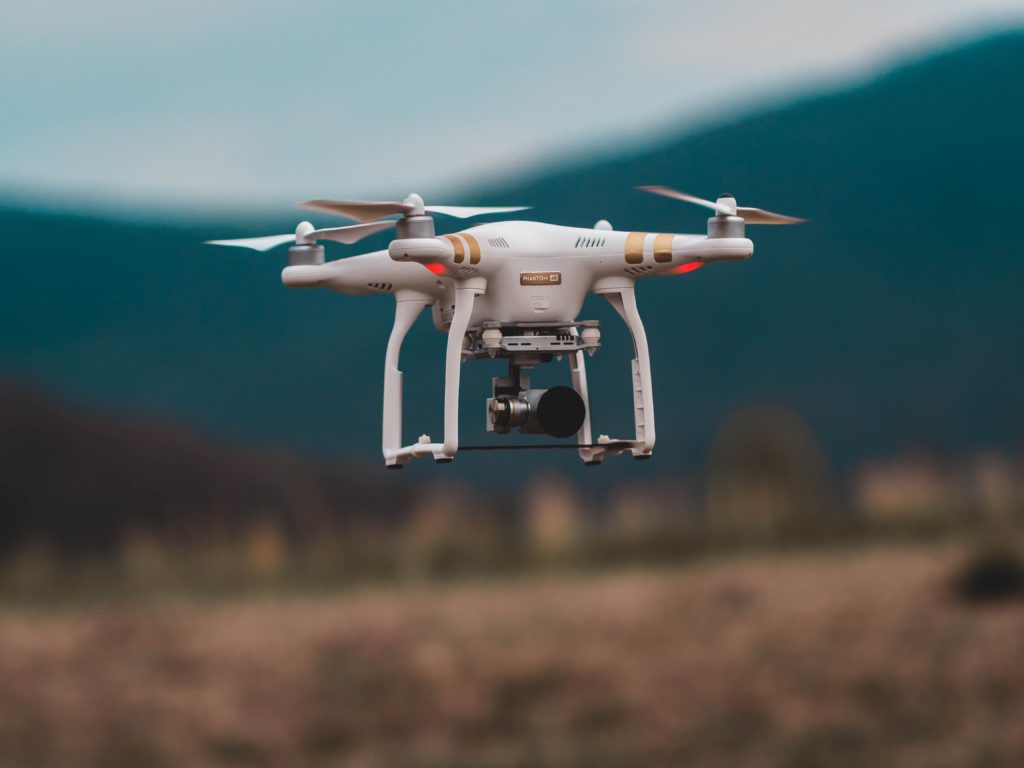
Who Is The Instructor? About John Peltier
As mentioned, it is important, when taking a drone qualification, to have an instructor that knows what they are doing. Your instructor for the Peltier course is John Peltier, founder of Peltier Photo Courses. As credentials go, you will not get much better. As well as being a fully certified FAA Part 107 Instructor, John has many years of military aviation experience.
He was both a pilot and instructor in the US Air Force flying F15s. He is also a commercially qualified pilot both in single-engined aircraft and helicopters. John’s qualifications don’t stop there however, he is also a highly accomplished documentary photographer, accredited to Photographers Without Borders.
However, having a highly qualified instructor is only half the story when studying. You need good quality course materials, engaging content and the ability to monitor your progress as you learn. So does the Peltier Remote Pilot Course have these? Let’s find out.
The Website Design And Dashboard
The website is a very clean design and it is clearly split into photography courses and remote pilot courses. When you sign up to an account and purchase a course you are given access to your dashboard. Here you will see all of the courses that you have signed up for and be able to resume each and the point where you left off.
One nice feature is that when you hover your mouse over the course thumbnail, it expands and gives a brief summary of that particular course and a play button that will take you to your last point in that course.
Another useful feature of the main site is the live chat button. Here, representatives of Peltier will answer your questions as soon as possible. It’s always nice to have that personal touch when learning. Having navigated the website layout, we now come to the course layout.

The Course Layout
Again one of the key things required when learning is a well-defined course layout. It’s important to what you will learn in each section. It is also important to be able to navigate through that course easily. When I was taking my A2 CofC, I found a couple of times where I needed to return to a video to enhance my knowledge a little more. Finding that video quickly and easily meant that I didn’t “leave it for another time” and then neglected it.
Fortunately, the Peltier Remote Pilot Course is very well laid out and easy to understand. Anyone who has used any of the main educational websites such as Udemy will recognise the workflow.
Starting top left of the course page we have the progress report. This is an important part of your learning process as it shows that you have taken the time to look at each individual lesson and mock exam.
Beneath this are the main sections of the course. In the case of the Part 107 Remote Pilot course there are six sections. We will look at them in depth later. Each section can be opened to reveal the coursework within, laid out in the order that you are expected to take the course.
The coursework is predominantly video-based but also contains study guides, reference guides and quizzes. Quizzes are multiple choice and you will find out your score at the end of each one. They are a useful guide as to your progress through the course.
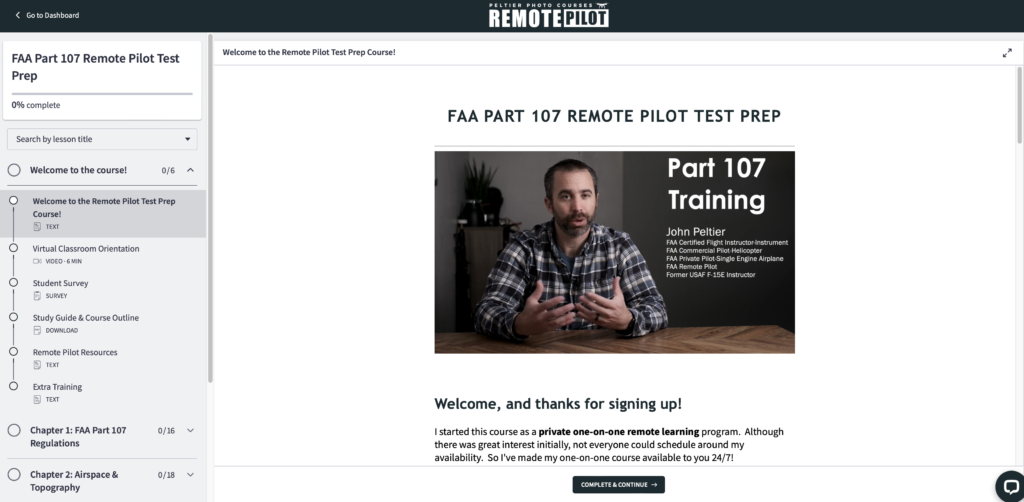
The Learning Experience
The learning experience can be broken down into two areas, the quality of the presenter and the quality of the course material. Let’s kick off with the presenter, John Peltier. In the initial welcome video we get to both see and hear John as he tells us about the course. He is clear, articulate and informative. His delivery is at a nice pace, at least as far as I am concerned. He is not talking too fast and gives suitable time to divulge what he just said.
Personally I very much like the camera approach. I had a very similar experience with Matt Williams at the UAVHub in the UK and find seeing the instructor an integral part of the learning experience.
Unfortunately for the remainder of the course, with the exception of section introductions, John hides himself away behind charts and diagrams. To me, that’s a little bit of a shame as he is a very watchable presenter. That said there is absolutely nothing wrong with the graphical elements of the course. I just feel that as students, we would be better served by seeing John more often, if only to break up the stream of graphics.
Moving on to the quality of the coursework and I have no complaints. There is an awful lot of very dry, potentially boring information that you have to digest to become a qualified drone pilot. Whilst much of it is not particularly mentally taxing, it does become much easier to understand when we have a well-thought-out graphic explaining it. Here, the Remote Pilot course does very well.
John uses a combination of well-designed graphics, clear, well-targeted text plus some lovely-looking images, possibly from John’s own library.
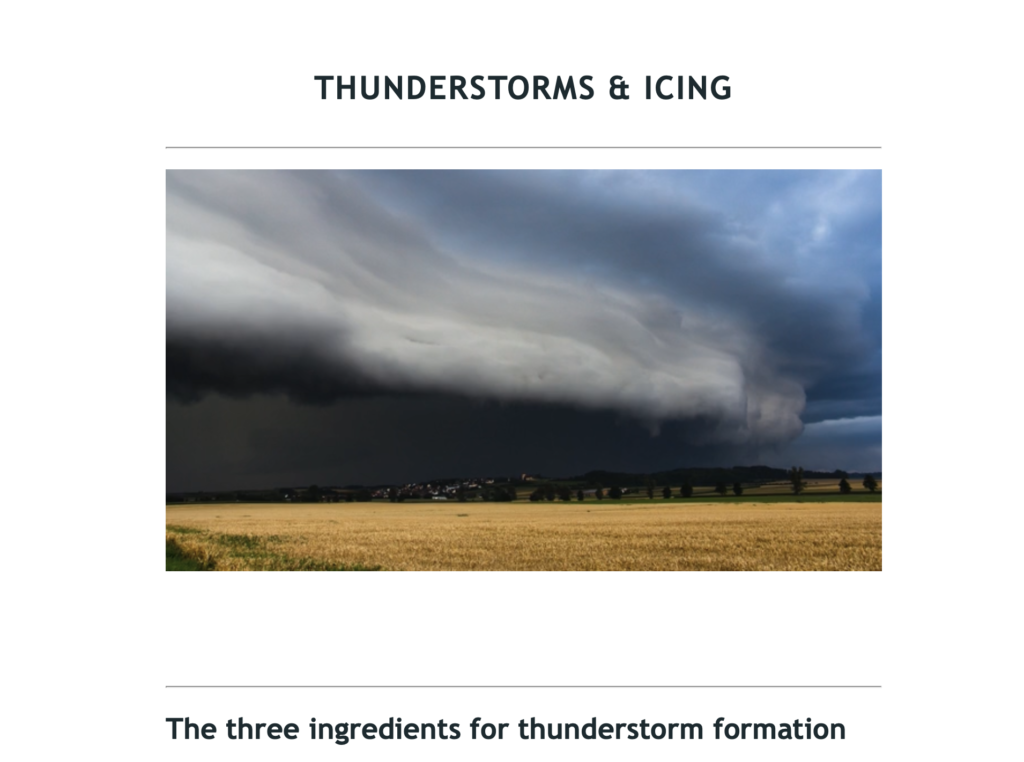
Within each section are several multiple choice quizzes to test your knowledge of the subject you have just learnt. The quizzes are of an interactive nature. You will be confronted with a question and it’s possible answers. You select the answer you believe to be correct and click Confirm. You will then find out if that answer is correct or not. If it is not, you will be told the correct answer. At the end of each quiz you will be given your final score and score percentage. This is a very useful way of keeping track of where your knowledge is lacking. You can retake the quizzes as many times as you like in order to make sure you are fully conversant with each subject.
Overall the learning experience is excellent, professional and well thought out. Now let’s take a look at what you will actually learn.
The Course Subjects
In this section I will briefly go through each section of the course, outlining what you will learn and giving a little context as to why this is important to a drone pilot.
The Welcome Section.
This is self-explanatory and contains six sections. They are:
- Welcome to the Remote Pilot Test Prep Course – This is where we get to see John
- Virtual Classroom Orientation – A quick look at how to use the course
- Student Survey
- Study Guide and Course Outline – A downloadable PDF.
- Remote Pilot Resources – An excellent section with links to useful books,
- Extra Training – A small section advertising more personalised remote pilot training.
Chapter 1: FAA Part 107 Regulations.
This is perhaps the driest part of the course and that’s possibly the reason John has chosen to cover it first. Like with other aviation authorities, the FAA is full of rules, guidelines and definitions. Whilst they might seem trivial, it is actually very important to learn and understand them. The parts in this section are:
- Introduction to Regulations
- Definitions (14 CFR Part 1) – Covering topics such as pilot in command and night flying
- sUAS Registration (14 CFR Part 48) – An important section as you risk a fine if you do not comply
- General Rules (14 CFR Part 107)
- sUAS Pilot Certification (14 CFR Part 107)
- Operations Part 1 (14 CFR Part 107) Operations Part 2 (14 CFR Part 107)
- Operations Part 3 (14 CFR Parts 107 & 89) – The above three sections deal a lot with the safety and administrative aspects of commercial drone flight.
Chapter 2: Airspace and Topography
This might sound like a fairly dry area but personally, as an aviation buff, I find it very interesting. It is also a very important section to fully understand as it deals with your drone in relation to not only manned aircraft but also understanding where your drone is in relation to its surroundings.
- Controlled & Uncontrolled Airspace – its vital to know what type of airspace you are in.
- Class G Airspace
- Class E Airspace
- Class D Airspace
- Class C Airspace
- Class B Airspace
- Special Use Airspace – In particular military airspace
- Topography.
This section is very well illustrated using real-world aviation maps to demonstrate each of the different concepts.
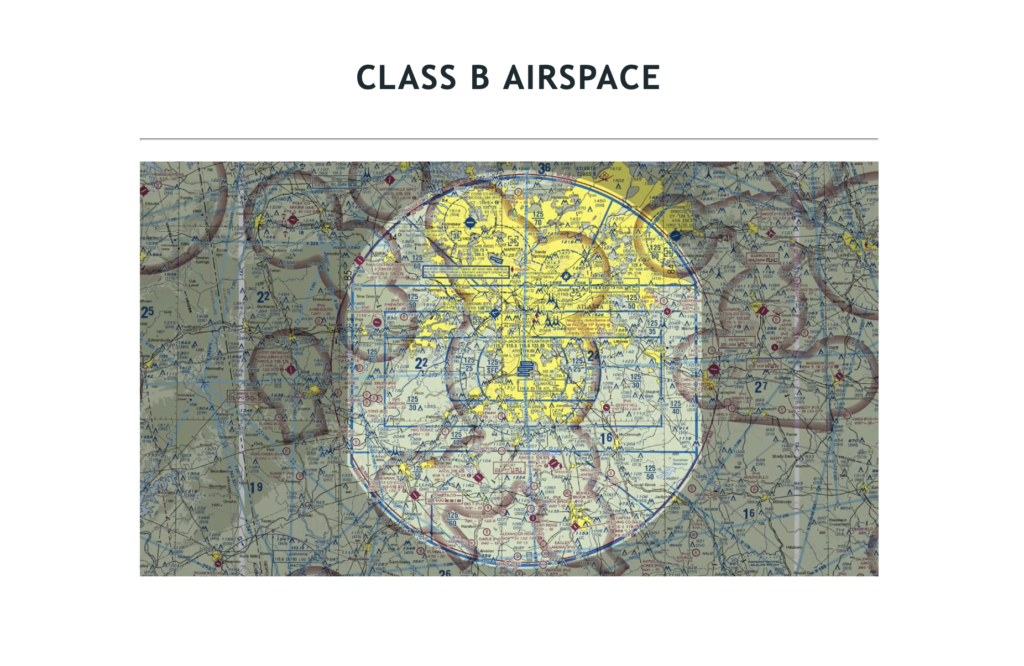
Chapter 3: Operations.
Operations, as its name suggests deals with the actually flying of the drone. Whilst you might think that you can just turn up and fly, there is much more to it than that. Vicinity to airports, NOTAMS (aviation notices), communications and physiology are all factors that must be considered when preparing a commercial drone flight. In this section, you learn:
- Airport Operations
- Notices to Airmen (NOTAMS)
- Communications
- Reading a Chart
- Emergencies – A very important subject as a drone issue may occur at anytime
- ADM & CRM – Aeronautical Decision Making and Crew Resource Management
- Physiology & Night – Your own personal fitness to fly is an important consideration.
Chapter 4: Weather
Weather can have a profound effect on both flying a drone and the decision whether to fly a drone. Apart from the obvious element, wind, factors like precipitation, icing and fog can all degrade the safety of a drone flight.
- Weather & Winds
- Temperature & Pressure
- Moisture, Fog, & Clouds
- Stability
- Air Masses & Fronts
- Thunderstorms & Icing
- Weather Reports
Chapter 5: Performance
Users of small drones might not think too much about the aircraft’s performance but they should. It doesn't matter if your drone is a simple 250g quadcopter or a massive 20kg octocopter, there are important elements that you need to know about its performance.
Chief amongst these is its weight, as this often defines what you can and cannot do with the drone. Also, speed is important, the effect of wind on your drone may mean that it does not have the power to fly back to your location.
- Weight & Balance
- Basic Aerodynamics
- Load Factor – Adding things to your drone can take it out of its official classification category.
- Determining Performance – Very important to know in combination with wind speed and gusts.
- Preflight Duties – Just as in manned aircraft, checks are a vital way to prevent incidents.
As you can see there is a substantial amount of information that needs to be studied. The course deals with this in an engaging and visually stimulating way and I found it an excellent way to learn.
After the main course videos and exams there are two further sections.
The first is the FSS Part 107 Practice Test. This comprises of a video on test-taking tips followed by a 60-question multiple-choice mock test. The questions for this come from the official FAA test (actual FAA questions) and are randomly selected each time you take the test hence this test acts as a very effective FAA Part 107 Study Guide.
The very last section of the course deals with booking your actual FAA Part 107 examination and what to do once you have passed.
In Summary
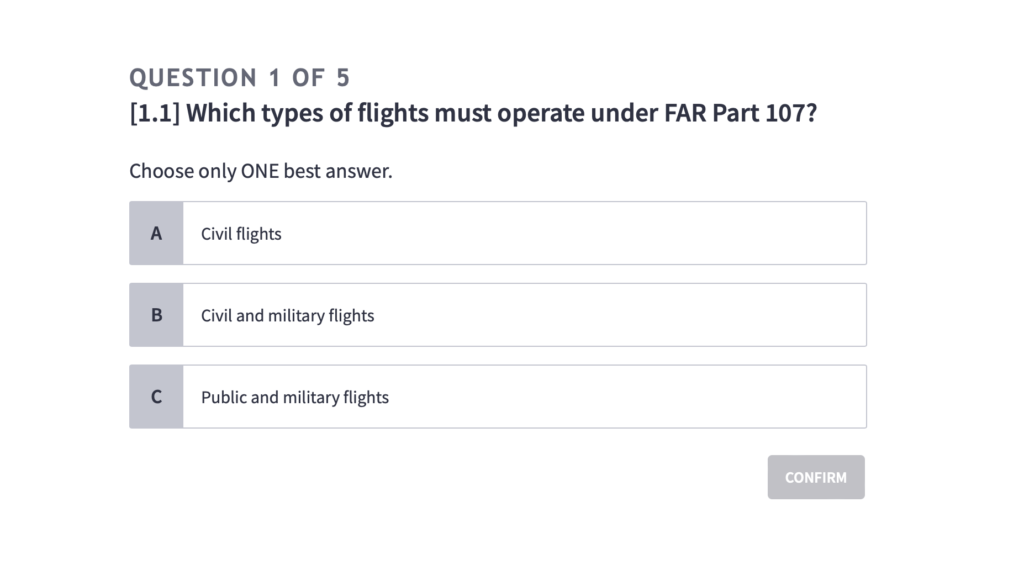
Results
According to the Peltier site, the average pass grade for Peltier students on their final exam for the drone pilot license is 93% which is quite a remarkable result.
Overall I found the Peltier drone course to be an excellent way to study for the Part 107. I am in someways at an advantage as much of the coursework is very similar to that of the old CAA PFCO, however the FAA regulations can be significantly different.
Some of the more important factors that may sway you towards this drone course are the undoubted qualifications of its tutor, the money-back guarantee, the part 107 practice test, the fact that the course is updated to current regulations and the access to live chat with a real person to help you through any difficulties. The quality and professionalism of the course make it well worth the outlay. If I were a US-based drone photographer, this course would certainly be at the top of my list.
Peltier Drone Course Discount!
If you are serious about taking the Peltier Drone Course, then make sure you secure your discount by using the code “LIGHT15” when making your order.



